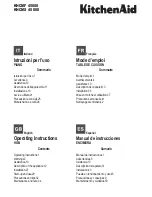
33
4.4 Cleaning
The
hood
must be cleaned immediately after it is installed and the protective cover is removed in order to remove any residual
glue
or other impurities
The inside and outside of the
hood
must be cleaned regularly (at least once a month).
Do not let dirt build up on the inside or outside of the
hood
.
The following products may be used on the decorative outside of the
hood
, made from treated, polished, black stainless steel:
A neutral solvent.
•
Liquid detergents or glass cleaning products;
•
Neutral liquid soap (for grease);
•
Soft cloths (rub following the direction of the finished surface; do not rub against this direction or use circular motions).
Warning!
The following products MUST NOT be used:
•
Products that contain chlorides, particularly hydrochloric acid;
•
Products that contain halogenides;
•
Products that contain hydrogen peroxide ;
•
Bleaches that contain hypochlorous acid;
•
Aggressive cleaning products that contain acids;
•
Detergents that contain abrasive powders;
•
Products to clean silver;
•
Any detergents if you do not know what chemicals they contain;
•
Scouring pads or brushes;
•
Rough cloths or paper;
•
Tools that have been used to clean other metals or alloys.
Cleaning before first use
Remove the protective plastic. Some circular marks or stains may be left behind and must be cleaned with a neutral solvent. After
this, clean with a neutral soap or liquid detergent. Use only soft cloths and rub following the direction of the finished surface; do
not rub against this direction or use circular motions.
Everyday cleaning
•
Clean the product regularly to make sure that dirt does not build up. If dirt builds up, this could result in an abrasive effect..
•
Use an air blower or vacuum to remove dust from the product before cleaning it. Dust on the product can scratch the surface..
•
If you use water to clean or rinse the product, and particularly if you live in a hard water area, dry the surface to make sure no
water marks are left.
•
To make sure there is no contamination from iron particles, do not use cleaning tools that have been used for other metals or
alloys..
•
Use only cleaning tools made from stainless steel.
•
You must carefully clean the grease filter. This filter catches grease particles in the steam. You must also carefully clean the
grease collection plate. This plate holds on to any grease the drips out of the grease filter. The filter and plate must be washed
when the display tells you to, or otherwise, at least once a month. Wash them in hot water with detergent (you can also put
them in the dishwasher).
•
The filter may get stained after a few washes. This is not a problem and it does not need to be replaced
•
To clean the metal grease filter and collection plate, you must remove them from the vent.
•
To remove the metal grease filter and collection plate, following the instructions in Figure 46 of the subsection WHAT TO DO
IF THERE IS LIQUID INSIDE THE
HOOD
in the section HOW IT WORKS. You must clean both the right and left vent shutters.
•
If you have a carbon filter, you do not need to wash this. However, it must be replaced if the display tells you to, or otherwise, at
least 3 or 4 times per year.
•
You can get new filters from your certified technical customer service.
•
To replace the anti-odour carbon filter, read the instruction manual in the kit sold separately.
Содержание SOTH1900B
Страница 1: ...Vented hob User guide EN Table induction aspirante Manuel d utilisation...
Страница 2: ...2...
Страница 3: ...3 SOTH1900B Fig 1 Fig 2...
Страница 18: ...18 NOTES...
Страница 19: ...19...
Страница 20: ...Scholtes com 2021_06...
Страница 35: ...35 NOTES...
Страница 36: ...36...
Страница 37: ...Scholtes com 2021_06...





































